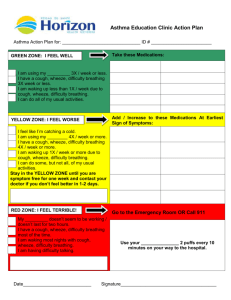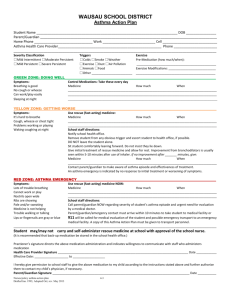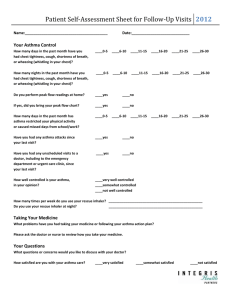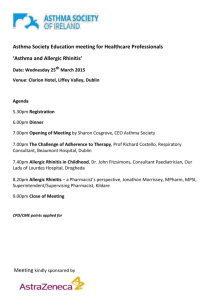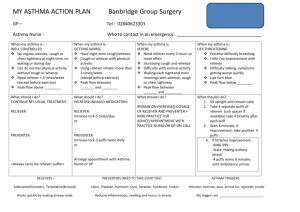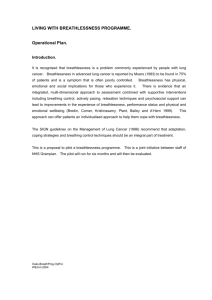cea12359-sup-0001-TableS1-S3-FigureS1
advertisement
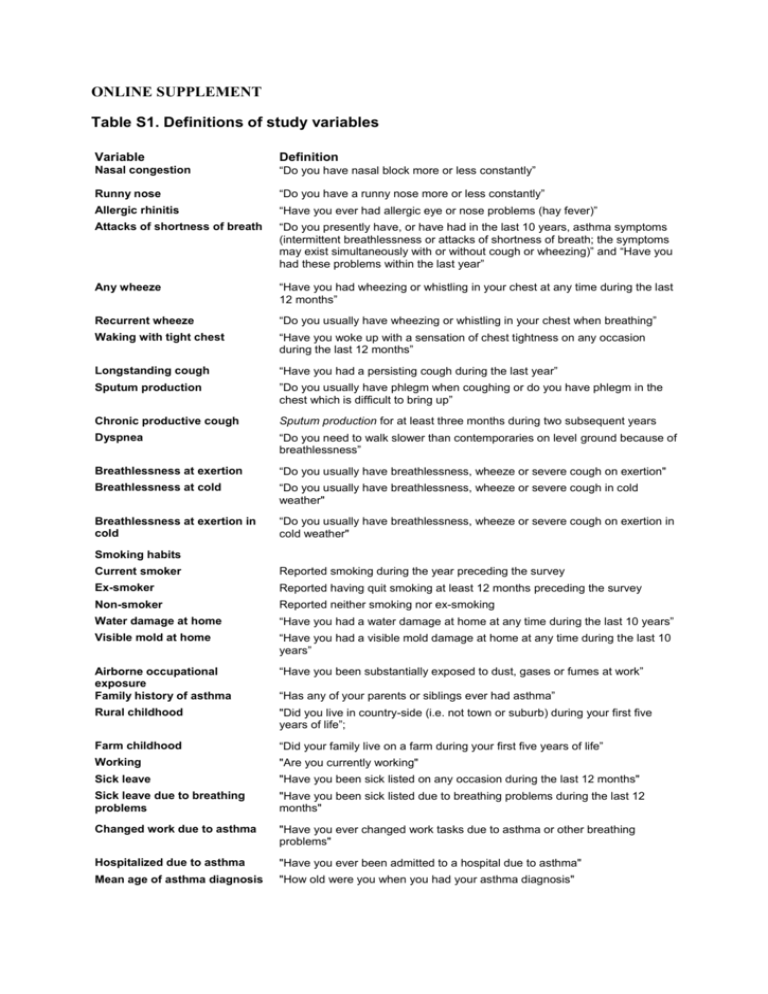
ONLINE SUPPLEMENT Table S1. Definitions of study variables Variable Definition Nasal congestion “Do you have nasal block more or less constantly” Runny nose “Do you have a runny nose more or less constantly” Allergic rhinitis “Have you ever had allergic eye or nose problems (hay fever)” Attacks of shortness of breath “Do you presently have, or have had in the last 10 years, asthma symptoms (intermittent breathlessness or attacks of shortness of breath; the symptoms may exist simultaneously with or without cough or wheezing)” and “Have you had these problems within the last year” Any wheeze “Have you had wheezing or whistling in your chest at any time during the last 12 months” Recurrent wheeze “Do you usually have wheezing or whistling in your chest when breathing” Waking with tight chest “Have you woke up with a sensation of chest tightness on any occasion during the last 12 months” Longstanding cough “Have you had a persisting cough during the last year” Sputum production ”Do you usually have phlegm when coughing or do you have phlegm in the chest which is difficult to bring up” Chronic productive cough Sputum production for at least three months during two subsequent years Dyspnea “Do you need to walk slower than contemporaries on level ground because of breathlessness” Breathlessness at exertion “Do you usually have breathlessness, wheeze or severe cough on exertion" Breathlessness at cold “Do you usually have breathlessness, wheeze or severe cough in cold weather" Breathlessness at exertion in cold “Do you usually have breathlessness, wheeze or severe cough on exertion in cold weather" Smoking habits Current smoker Reported smoking during the year preceding the survey Ex-smoker Reported having quit smoking at least 12 months preceding the survey Non-smoker Reported neither smoking nor ex-smoking Water damage at home “Have you had a water damage at home at any time during the last 10 years” Visible mold at home “Have you had a visible mold damage at home at any time during the last 10 years” Airborne occupational exposure Family history of asthma “Have you been substantially exposed to dust, gases or fumes at work” Rural childhood "Did you live in country-side (i.e. not town or suburb) during your first five years of life”; Farm childhood “Did your family live on a farm during your first five years of life” Working "Are you currently working" Sick leave "Have you been sick listed on any occasion during the last 12 months" Sick leave due to breathing problems "Have you been sick listed due to breathing problems during the last 12 months" Changed work due to asthma "Have you ever changed work tasks due to asthma or other breathing problems" Hospitalized due to asthma "Have you ever been admitted to a hospital due to asthma" Mean age of asthma diagnosis "How old were you when you had your asthma diagnosis" “Has any of your parents or siblings ever had asthma” Table S2. Prevalence of respiratory symptoms and conditions in aspirinintolerant (AIA) and aspirin-tolerant asthma (ATA). Nasal congestion Runny nose Chronic rhinosinusitis Allergic rhinitis Attacks of shortness of breath Any wheeze Recurrent wheeze Waking with tight chest Longstanding cough Chronic productive cough % % % % % % % % % % AIA ATA p-value 48.9 48.9 43.2 67.0 76.1 80.7 53.4 59.1 47.7 40.9 30.8 26.3 18.2 64.6 60.3 61.8 32.0 31.9 28.2 19.7 <0.001 <0.001 <0.001 0.73 0.003 <0.001 <0.001 <0.001 <0.001 <0.001 Table S3. Risk factors (OR 95% CI) for aspirin-intolerant asthma (AIA) and aspirin-tolerant asthma (ATA) by univariate analysis. Independent variables Dependent variables Female sex AIA vs. non-asthma OR (95% CI) ATA vs. nonasthma OR (95% CI) AIA vs. ATA OR (95% CI) 1.81 (1.16-2.84) 1.23 (1.11-1.36) 1.47 (0.93-2.33) Body mass index ≤20 >20 ≤25 >25 ≤30 >30 ≤35 >35 1 1.12 (0.39-3.19) 1.22 (0.42-3.54) 3.59 (1.21-10.70) 7.53 (2.35-24.16) 1 0.82 (0.67-1.01) 0.95 (0.77-1.17) 1.36 (1.07-1.73) 1.68 (1.22-2.31) 1 1.36 (0.47-3.94) 1.29 (0.44-3.79) 2.63 (0.87-8.01) 4.49 (1.36-14.85) Age 16-35 years 36-55 years 56-75 years 1 1.61 (0.97-2.67) 0.91 (0.50-1.63) 1 0.79 (0.70-0.89) 0.70 (0.62-0.79) 1 2.05 (1.22-3.44) 1.29 (0.71-2.35) 2.71 (1.73-4.26) 3.56 (3.19-3.97) 0.76 (0.48-1.21) 1 2.29 (1.36-3.85) 1 1.17 (1.04-1.33) 1 1.95 (1.15-3.31) 3.17 (1.92-5.22) 1.01 (0.88-1.16) 3.13 (1.87-5.24) Airborne occupational exposure 2.76 (1.80-4.24) 1.43 (1.27-1.60) 1.93 (1.24-3.00) Visible mold at home 3.73 (2.27-6.12) 1.47 (1.24-1.73) 2.55 (1.52-4.26) Water damage at home 2.14 (1.30-3.50) 1.22 (1.06-1.41) 1.75 (1.05-2.91) Rural childhood 0.69 (0.43-1.09) 0.99 (0.89-1.10) 0.69 (0.43-1.11) Farm childhood 1.04 (0.58-1.89) 0.76 (0.65-0.89) 1.38 (0.75-2.53) Allergic rhinitis 6.86 (4.39-10.72) 6.16 (5.53-6.86) 1.11 (0.71-1.76) Chronic rhinosinusitis 11.51 (7.52-17.64) 3.38 (2.93-3.89) 3.41 (2.19-5.29) Family history of asthma Smoking Non-smoker Ex-smoker Current smoker Figure S1. Correlation between BMI and peripheral blood neutrophil count (109/L).




